Traditional round Carib meeting house
Chewing On Carib History
Because some upcoming Maasdam destinations have strong affiliations with the Carib(pronounced kar-RIB) Indians, this seems like a good time to mention their place in island history.
Fiercely independent. Unyielding. Vanished. That pretty much sums up the status of the Carib Indians throughout the Caribbean, the island group named after them.
Despite rumors to the contrary, Caribs still can be found on Dominica and St. Vincent and along the coasts of Honduras and Guyana, but elsewhere in the Caribbean they have disappeared, the victims of Europeans diseases and brutality.
One of the largest surviving groups of Caribs, who often refer to themselves as the Kalinago or Garifuna people live inside the 3,700-acre Carib Territory on Dominica. About 3,500 Caribs live inside the Reserve and another 2,000 live elsewhere on the island, the largest group of island Caribs left anywhere in the world.
\
Carib woman selling her hand-made baskets
The Carib villages extending for 9 miles along the island’s east coast are almost indistinguishable from other parts of the island. Small wooden and concrete houses largely have replaced the traditional round great houses and A-frame buildings.
Except for two small signs marking the northern and southern ends of the Carib Territory (also sometimes referred to as the Carib Reserve. Visitors pass occasional roadside stand selling hand-woven baskets, there’s nothing to indicate you’re among the Caribs, a people who so terrified early explorers that they were relentlessly hunted almost to extinction.
They survived on Dominica only because of the mountainous landscape that made pursuit of them difficult and dangerous. The French and later the British found it made more sense to trade with the Caribs than to fight them.
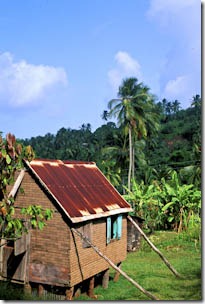
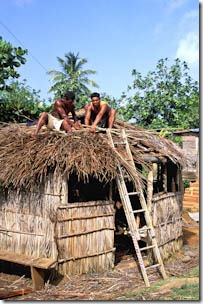
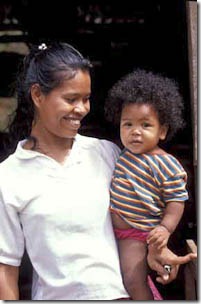
Carib Territory homes new and old-style; Carib woman with her son
The Caribs were not the original settlers of the Caribbean but part of the second wave of Amerindians from South America. The Tainos arrived first, about 500 B.C., and the Caribs appeared in their canoes about a thousand years later. Greater seamanship skills and a more war-like mentality allowed the Caribs to conquer and absorb the Tainos. They expanded as far north as Puerto Rico.
European explorers found the Caribs to be formidable opponents. They often fought to the death rather than endure slavery. On St. Vincent they were considered so dangerous that the cannons at one fort pointed inland; the Caribs were considered a far greater threat than any opponent who might arrive by sea.
The battle between guns and arrows also turned into a war of words, and the most effective propaganda story of the day was that the Caribs were “man eaters.” This resulted in the invention of a new term, “cannibal,” a corruption of what the Spanish called the Caribs, “Caribales.” Demonizing the Caribs as cannibals was a good excuse for European explorers to kill or enslave them and seize their land.
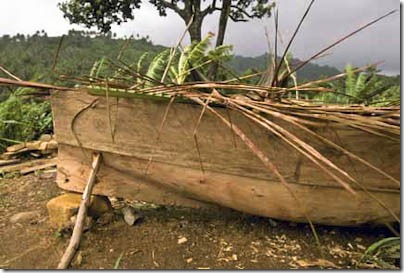 The Caribs were skilled sailors despite their primitive dugout canoes
The Caribs were skilled sailors despite their primitive dugout canoes
One of the wildest stories was from a French priest in the 1600s who reported that the Caribs had performed their own taste test on Europeans and concluded that the French were the tastiest, followed by the English, Dutch and very much in last place the Spanish (said to be too stringy to be worth eating).
Today’s Caribs steadfastly maintain their ancestors were not cannibals. The film was criticized the popular The National Garifuna Council criticized the popular Pirates of the Caribbean: Dead Man’s Chest for portraying the Carib people as cannibals. Adding insult to injury was where parts of the film were shot: on Dominica.
Some historians says that what was mistaken for cannibalism actually was an important part of war rituals where the limbs of victims were taken back to their villages as trophies.
A victorious Carib apparently chewed and spit out a single mouthful of flesh of a very brave enemy so that bravery would be transferred to them. There is no evidence that the Caribs ever ate humans to satisfy hunger.
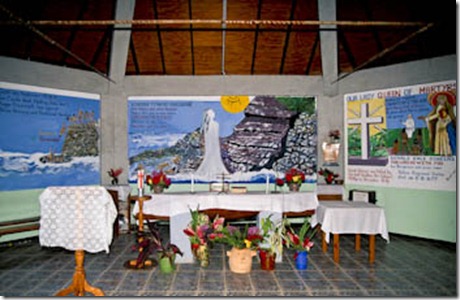 Because of the canoe’s importance in Carib history, canoes
Because of the canoe’s importance in Carib history, canoes
are used as altars in some Carib Territory churches.

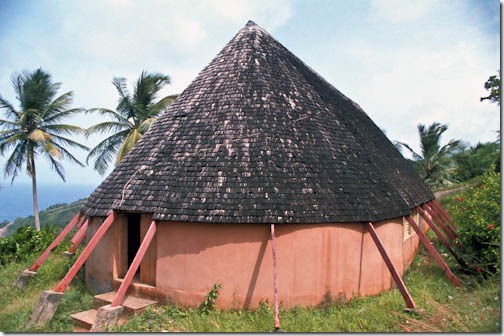
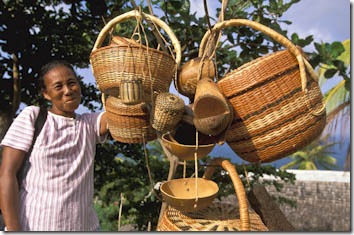
 Follow
Follow